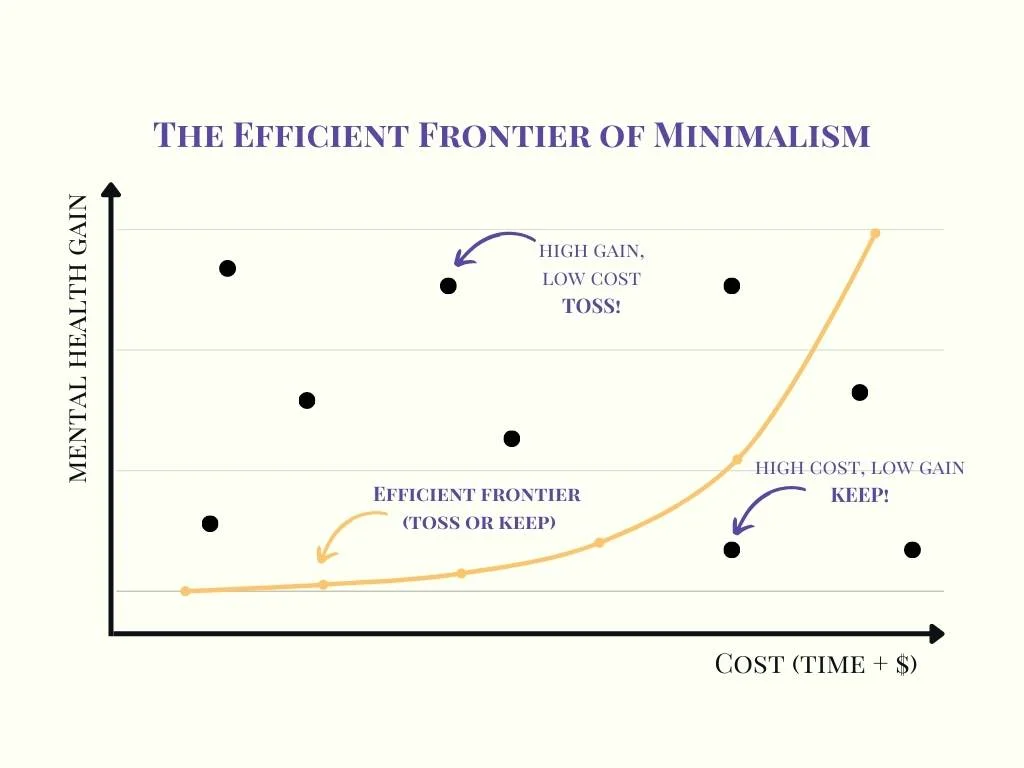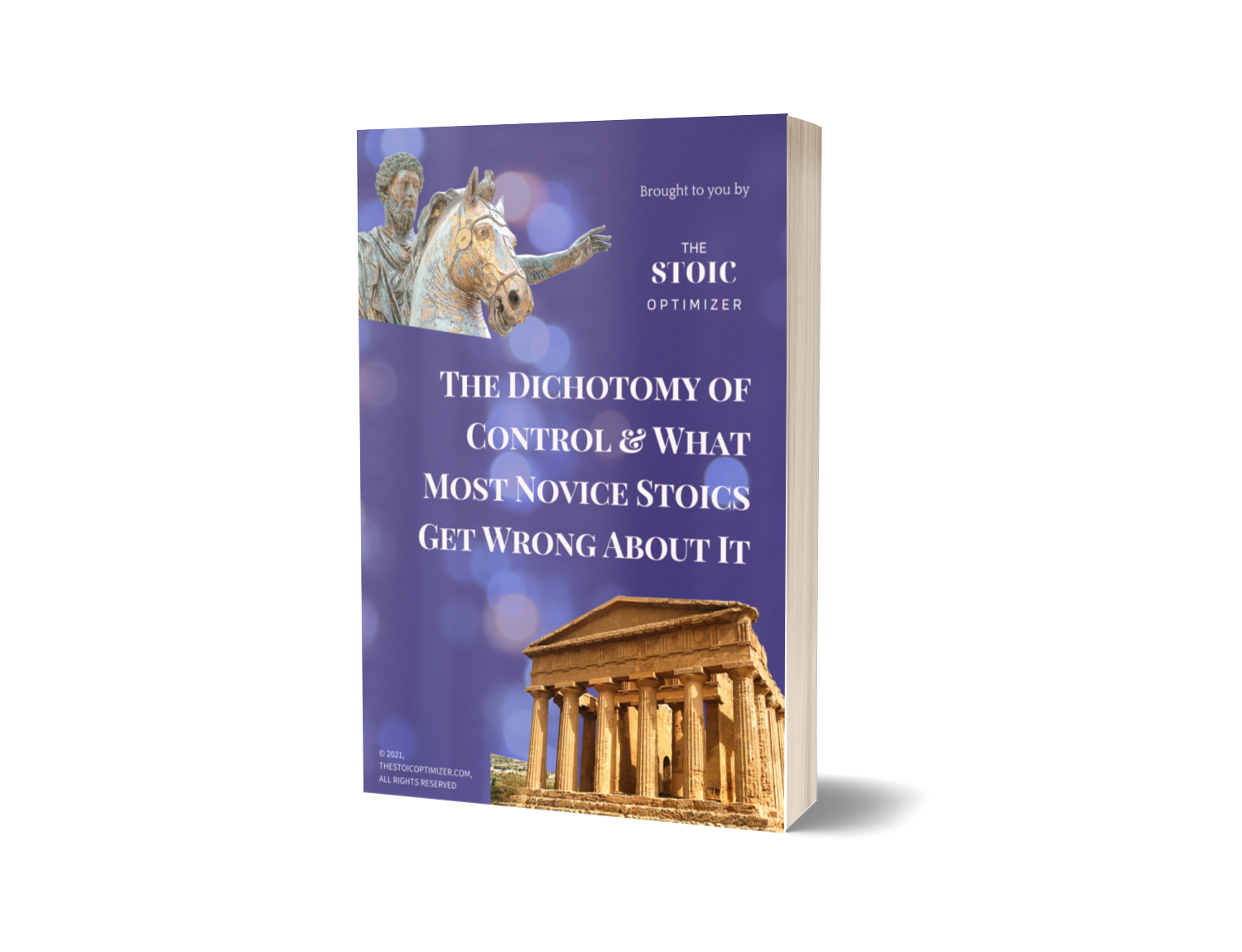Minimalism is all the rage these days. Get rid of your clutter and mental clarity will follow, so the saying goes. But that’s likely not what you’ve experienced (or will experience) if you turn into Marie Kondo for the weekend. At least not for the long term. Keep reading and I’ll show you why minimalism is not just for the rich and privileged and how you can make it work for you if you have the right decision-making tool to sort through your clutter.
The 2 Key Assumptions that Underlie Minimalism
The main assumption underlying minimalism is that you have too much stuff that is eating up your time and energy due to its administration. With the overabundance of marketing and shopping opportunities, it’s easy to see how this is the case for a lot of people these days.
The second one is that if you’ve chosen the wrong things to discard, you can easily replace the missing item when the need arises, while still benefiting from a clean and empty house in the meantime. This is where the whole “minimalism is for the rich” shtick comes from - most people cannot afford to spend money again on an item they already bought but use infrequently, just because they threw it away on a whim while testing whether less stuff will bring them more peace and happiness.
The truth is, it doesn’t matter how rich you are, throwing away stuff you will need in the future is a waste of resources and thus suboptimal. Discarding a useful item now (emphasis on useful) means borrowing time from your future self to acquire it again due to the saga of reading the reviews on which one to choose and actually purchasing it. Depending on how urgently you need the thing, anxiety may or may not be added to the mix.
That sounds like the exact opposite of what we want to achieve with minimalism, so we’ve established that you can have minimalism go too far. Why does it happen, though?
I’d argue that the root cause is simply a misjudgment of how much we will benefit from throwing away a thing, rather than from keeping it, based on our perceived need for it in the future. As the intimidating pile of stuff to sort through lies in front of us, we are forced to make the call in a snap, so we don’t give ourselves enough time to consider all the consequences.
Now that we’ve identified the problem, we can start to think of a solution.
How can you make sure that when you’re under the spell of that minimalist spirit and you pick up an item, you actually categorize it correctly in terms of deciding whether to keep or toss it?
The efficient frontier of minimalism to the rescue!
Imagine that every object you are trying to decide whether to keep or toss is a point on a chart. The vertical axis represents the mental health gain: this is how much you expect to benefit from getting rid of the object. The horizontal axis is an item’s replacement cost, defined in terms of the time and money it takes to replace an item if you’ve wrongly discarded it. To make minimalism work, we need to find the best trade-off between these 2 variables.
Now, assume that we can find an efficient frontier for minimalism - a line that separates our chart in 2 regions: stuff that is worth keeping and stuff that we are better off throwing away. It would probably look something like this:
Note that the efficient frontier could just as well be a straight line, but looks more like an exponential due to the fact that we want to skew towards discarding more stuff. More on how to define this later.
The points that lie above the efficient frontier of minimalism bring you the maximum amount of gain in terms of mental clarity and the least amount of cost if you have to replace them. Those are the ones you should declutter first.
The points under the curve represent those that have a high replacement cost and low decluttering benefit. These you’re better off keeping.
As a rule of thumb, if you’ve estimated the cost and benefit correctly for an item, the farther away it is from the line, the more of a no-brainer the decision is. So to implement minimalism with the lowest potential for regret, find your efficient frontier, then find the location of each item on the chart and do what the graph says. Rinse and repeat for all items you’re considering tossing.
Defining the efficient frontier of minimalism for your situation
For each type of item, you already have some kind of mental threshold of what you are willing to spend to replace the item in order to alleviate its mental burden. That’s where you should start from.
To better understand this, let’s look at the example of Alice, who is saving money for a world trip, but who also prioritizes minimalism. Alice has a stand mixer that takes up a ton of space in her kitchen, but only bakes once a year for Christmas. Under these conditions, should Alice keep or toss the device?
Since Alice values reaching her goal of going on a world trip more than a perfect implementation of minimalism, she should keep the mixer, at the expense of a more cluttered house. If the price of the mixer and its mental health benefit would be a perfect trade-off for each other - she wouldn’t want to spend a dollar more on replacing the mixer, but is perfectly fine with spending the mixer’s cost - the device would lie on the efficient frontier.
This means that if you want to define your own efficient frontier for minimalist pursuits, you have to find the maximum amount of money you are willing to spend to replace an item that gives you a specific amount of mental health due to decluttering. In other words, all you have to do is figure out how much that (mental) space is worth to you.
Of course, I don’t expect you to do an actual calculation, but this reframing of the problem should help you decide faster whether to keep an item and accept the downsides of doing so, while at the same time minimizing the regret of going overboard with minimalism.
By now you should be full of enthusiasm about decluttering and more confident in your abilities to do it successfully. I don’t want to keep you from applying what you’ve learned, but I do want to outline one broader takeaway from this post before you go.
Key Takeaway:
The efficient frontier is a good mental model to use when thinking about trade-offs since it forces you to consider at least 2 variables that influence the outcome - usually one of them will quantify some kind of gain, while the other will represent a risk.
Anything that falls under the “more is not necessarily better” category is a suitable candidate for consideration using the efficient frontier framework. I'm sure you'll find plenty of uses for it once you've tried it on minimalism.
What you need to remember is that not all combinations in a space of solutions are optimal and that sometimes you can find a curve that separates the good ones from the bad, which makes sorting through them a lot easier.
Disclaimer: this whole efficient frontier thing isn’t new and I didn’t come up with it, but to the best of my knowledge, it has never been applied to minimalism. The term was coined by a very smart guy called Markowitz - who went on to win the Nobel prize - when he was looking for a way to construct optimal investment portfolios. His trade-off was between ROI (return on investment) and volatility (a measure of risk). If you’re into economics and liked the concept, you can learn more about its original application here.
If you're looking for other useful mental models to help you reach your goals, this post about creating systems instead of relying on willpower might be right up your alley.

